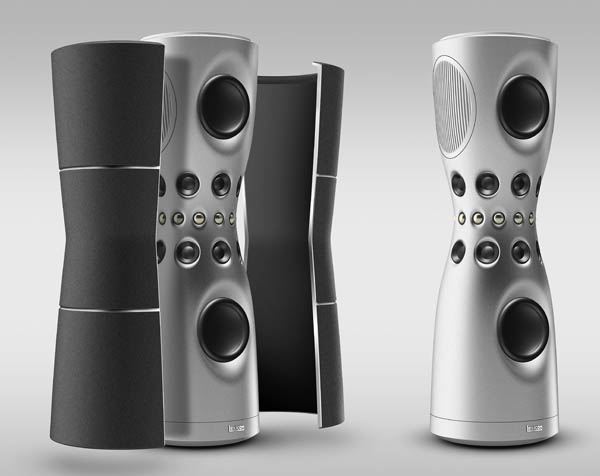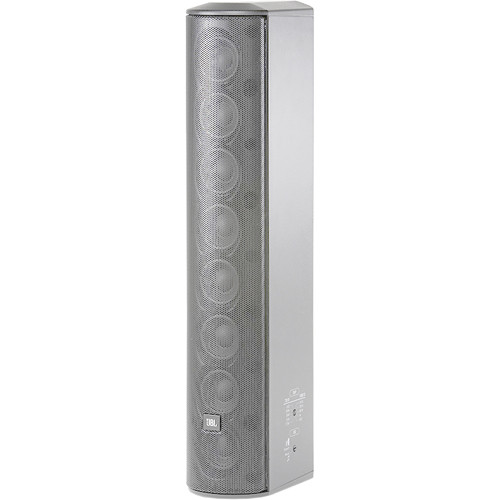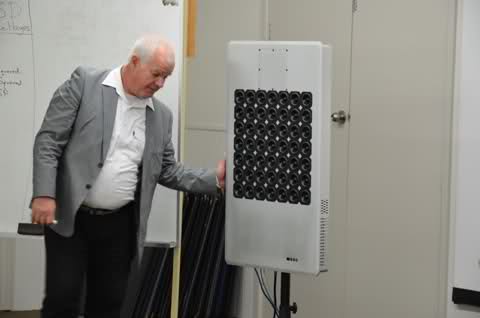I thought that speakers setup in a circular array like the Tekton Double Impact and Impact Monitor were not a good idea. Are they able to get away with it because they are tweeters?
I'd like to know whether this kind of configuration could work well with full range drivers and what benefits it would have (beyond just efficiency)? Any potential drawbacks like comb-filtering and what does that sound like?
Impact-Monitor - TektonDesign LLC
I'd like to know whether this kind of configuration could work well with full range drivers and what benefits it would have (beyond just efficiency)? Any potential drawbacks like comb-filtering and what does that sound like?
Impact-Monitor - TektonDesign LLC
In that speaker they run the tweeters in a 0.5 arrangement where the outer ring rolls off in the HF leaving just the central tweeter. Perfectly acceptable & functional & an effective way to increase midrange radiating area, although potentially a rather expensive way of creating a midrange driver or coax.
As Scott says, the ring of tweeters is to act as a midrange… at the expense of destroying the C-C distance, and likely not being able to go as low as a real midrange.
dave
dave
Interesting. It does sound like a different way to make a coaxial.
Basically [re]creates a bit more uniform version of a large non-whizzer 'wide-range' driver's HF polar response where the lower HF is 'launching' out where the surround is attached, random break-up modes scattered around the middle part of the diaphragm and horn/bell modes down around where the VC's diameter set's the driver's actual HF limit plus any dust cap modes.
IOW, above the VC's pass-band [~13,560"/pi/diameter o.d.] it's mostly ~euphonic distortion, so using a bunch of [tapered] smaller VC drivers makes for more signal accuracy if not actually an overall superior sounding speaker since the reality is that we all basically hear the same, yet not so much.
FWIW, to date, ignoring the DSL SH50 horn, the best overall performing large 'FR' driver from ~100-12,000 Hz I've auditioned is a multiple ring array using a bunch of old console, table radio, etc., 'FR' drivers, hence the relatively narrow range by today's standards. Line arrays have their charms, but 'sound is round', so mimicking a round driver/horn just sounds more 'right' to me, though obviously will be pretty wide to go low.
FWIW, for an inexpensive DIY multi-cell, arranging [super] tweeters to mimic its mouth area/shape has been known to fool some if they can't see it. Worked great with cheap piezo horns, but was back when even cheap was quite good compared to today's: https://i.ebayimg.com/00/s/MTIwMFgxNjAw/z/tmEAAOSwySVaSqTi/$_1.JPG
GM
Agreed. Actually, for all the unusual (by current standards) appearance, I quite like what Tekton have done with their multiple tweeter arrays. Get a low Fs unit sans ferrofluid &, say, 1mm linear travel, you can run 7 of them down < 1KHz easily enough, then roll off the outer ring as desired either technically or however desired. It's about the same total radiating surface as a 4in midrange unit & the efficiency should be high if you pick the drivers well. Perfect? Nope, but it can work well enough. Jon Atkinson's measurements of the Impacts show a reasonably thought out design on-axis. Tekton Design Impact Monitor loudspeaker Measurements | Stereophile.com
Some random ideas for you to consider:

Those drivers don't have to be on a flat baffle. If you wrap them around a shape, like a cylinder or a spherical cap, you can change the wavefront shape from flat to curved, which will increase the beamwidth. You can also manipulate the wavefront shape with DSP delay, shading, or both.

DSP digital delay and curved enclosures are not cheap. JBL took an interesting route, they 'curved' their CBT with a passive crossover. Basically a low pass filter introduces a delay, so JBL used a series of low pass filters on their inexpensive CBT to curve the wavefront. The full range drivers in the center are unfiltered and have no delay, as you get closer to the top and the bottom of the array, the delay and the filter increases. Clever.
I posted a couple threads on both of these, if you'd like to check it out.
And note that these arrays are one dimensional, but you can make them TWO dimensional by using a matrix of full range drivers. For instance, five drivers x five drivers.
Those drivers don't have to be on a flat baffle. If you wrap them around a shape, like a cylinder or a spherical cap, you can change the wavefront shape from flat to curved, which will increase the beamwidth. You can also manipulate the wavefront shape with DSP delay, shading, or both.

DSP digital delay and curved enclosures are not cheap. JBL took an interesting route, they 'curved' their CBT with a passive crossover. Basically a low pass filter introduces a delay, so JBL used a series of low pass filters on their inexpensive CBT to curve the wavefront. The full range drivers in the center are unfiltered and have no delay, as you get closer to the top and the bottom of the array, the delay and the filter increases. Clever.
I posted a couple threads on both of these, if you'd like to check it out.
And note that these arrays are one dimensional, but you can make them TWO dimensional by using a matrix of full range drivers. For instance, five drivers x five drivers.
I thought that speakers setup in a circular array like the Tekton Double Impact and Impact Monitor were not a good idea. Are they able to get away with it because they are tweeters?
Impact-Monitor - TektonDesign LLC
When you have two drivers and they're both playing at equal volume, they will interfere with each other. As they interfere, they'll generate an interference pattern, which produces comb filtering.
If you want to reduce comb filtering, you can reduce the voltage to one of the two drivers. For instance, if you reduce one of the drivers by 6dB, it will barely interfere with the other driver at all. You can simulate this in ARPE.
Another option is to simply run one driver full-range, and low pass the other one. By lowpassing one driver, you achieve the same result: at high frequency, one of the two drivers is attenuated, so they interfere with each other less.
The trick with that option is that the low pass filter introduces a delay, and that delay changes the shape of your wavefront. That could be a defect or a feature, depending on how you look at things. The Keele CBTs use a curved enclosure to generate a curved wavefront. The JBL CBTs use a flat enclosure along with a series of low pass filters to generate a curved wavefront. Basically the JBL curves the wavefront via the crossover.
When you have two drivers and they're both playing at equal volume, they will interfere with each other. As they interfere, they'll generate an interference pattern, which produces comb filtering.
How much interference goes up as the frequency represented by the centre-centre of the drivers. If the distance is less than a quarter wavelength it goes away (Danley).
dave
How much interference goes up as the frequency represented by the centre-centre of the drivers. If the distance is less than a quarter wavelength it goes away (Danley).
dave
Absolutely.
The reason that shading is so attractive is because it's really difficult to get tweeters close together.
For instance, I have some neo tweeters with a 3/4" diaphragm. Their flange is about 1.25". 10,800hz is 1.25" long.
That means that if I want these tweeters to behave like a single unit, their upper limit is 2700Hz! (10800hz divided by four)
Since I can't possibly get them that close together, shading them is a better option.
how about a square 7x7 array
https://www.diyaudio.com/forums/full-range/164797-200-2-drivers-15.html#post3151587

https://www.diyaudio.com/forums/full-range/164797-200-2-drivers-15.html#post3151587
- Home
- Loudspeakers
- Full Range
- Question about circular tweeter array like on the Tekton Double Impact